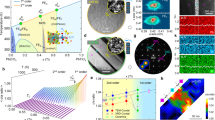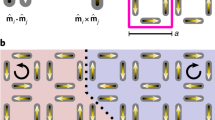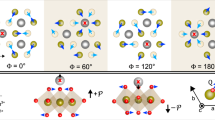Abstract
Geometric frustration is a broad phenomenon that results from an intrinsic incompatibility between some fundamental interactions and the underlying lattice geometry1,2,3,4,5,6,7. Geometric frustration gives rise to new fundamental phenomena and is known to yield intriguing effects such as the formation of exotic states like spin ice, spin liquids and spin glasses1,2,3,4,5,6,7,8,9,10,11,12,13,14,15,16,17. It has also led to interesting findings of fractional charge quantization and magnetic monopoles5,6. Mechanisms related to geometric frustration have been proposed to understand the origins of relaxor and multiferroic behaviour, colossal magnetocapacitive coupling, and unusual and novel mechanisms of high-transition-temperature superconductivity3,4,5,12,16. Although geometric frustration has been particularly well studied in magnetic systems in the past 20 years or so, its manifestation in the important class formed by ferroelectric materials (which are compounds with electric rather than magnetic dipoles) is basically unknown. Here we show, using a technique based on first principles, that compositionally graded ferroelectrics possess the characteristic ‘fingerprints’ associated with geometric frustration. These systems have a highly degenerate energy surface and display critical phenomena. They further reveal exotic orderings with novel stripe phases involving complex spatial organization. These stripes display spiral states, topological defects and curvature. Compositionally graded ferroelectrics can thus be considered the ‘missing link’ that brings ferroelectrics into the broad category of materials able to exhibit geometric frustration. Our ab initio calculations allow deep microscopic insight into this novel geometrically frustrated system.
This is a preview of subscription content, access via your institution
Access options
Subscribe to this journal
Receive 51 print issues and online access
$199.00 per year
only $3.90 per issue
Buy this article
- Purchase on Springer Link
- Instant access to full article PDF
Prices may be subject to local taxes which are calculated during checkout




Similar content being viewed by others
References
Moessner, R. & Ramirez, A. P. Geometric frustration. Phys. Today 59, 24–29 (2006)
Harris, M. J. Taking the frustration out of ice. Nature 399, 311–312 (1999)
Hemberger, J. et al. Relaxor ferroelectricity and colossal magnetocapacitive coupling in ferromagnetic CdCr2S4 . Nature 434, 364–367 (2005)
Anderson, P. W. The resonating valence bond state in La2CuO4 and superconductivity. Science 235, 1196–1198 (1987)
Laughlin, R. B. The relationship between high temperature superconductivity and the fractional quantum Hall effect. Science 242, 525–533 (1988)
Castelnovo, C., Moessner, R. & Sondhi, S. L. Magnetic monopoles in spin ice. Nature 451, 42–45 (2008)
Lee, S.-H. et al. Emergent excitations in a geometrically frustrated magnet. Nature 418, 856–858 (2002)
Wen, X. G. & Niu, Q. Ground state degeneracy of the fractional quantum Hall states in the presence of a random potential and on high genus Riemann surfaces. Phys. Rev. B 41, 9377–9396 (1990)
Hagemann, I. S., Khalifah, P. G., Ramirez, A. P. & Cava, R. J. Geometric magnetic frustration in olivines. Phys. Rev. B 62, R771–R774 (2000)
Lee, D. H., Joannopoulos, J. D., Negele, J. W. & Landau, D. P. Discrete-symmetry breaking and novel critical phenomena in an antiferromagnetic planar (XY) model in two dimensions. Phys. Rev. Lett. 52, 433–436 (1984)
Villain–Guillot, S., Dandolof, R., Saxena, A. & Bishop, A. R. Topological solitons and geometrical frustration. Phys. Rev. B 52, 6712–6722 (1995)
Mostovoy, M. Multiferroics go high-TC . Nature Mater. 7, 269–270 (2008)
Libál, A., Reichhardt, C. J. O. & Reichhardt, C. Creating artificial ice states using vortices in nanostructured superconductors. Phys. Rev. Lett. 102, 237004 (2009)
Sethna, J. P. Frustration and curvature: glasses and the cholesteric blue phase. Phys. Rev. Lett. 51, 2198–2201 (1983)
Balents, L. Spin liquids in frustrated magnets. Nature 464, 199–208 (2010)
Cheong, S. W. & Mostovoy, M. Multiferroics: a magnetic twist for ferroelectricity. Nature Mater. 6, 13–20 (2007)
Papanikolaou, S., Raman, K. S. & Fradkin, E. Devil’s staircases, quantum dimer models, and stripe formation in strong coupling models of quantum frustration. Phys. Rev. B 75, 094406 (2007)
Dawber, M., Rabe, K. M. & Scott, J. M. Physics of thin film ferroelectric oxides. Rev. Mod. Phys. 77, 1083–1130 (2005)
Okatan, M. B., Roytburd, A. L., Mantese, J. V. & Alpay, S. P. Domain engineering in compositionally graded ferroelectric films for enhanced dielectric response and tunability. J. Appl. Phys. 105, 114106 (2009)
Bin-Omran, S., Kornev, I., Ponomareva, I. & Bellaiche, L. Diffuse phase transitions in ferroelectric thin films from first principles. Phys. Rev. B 81, 094119 (2010)
Bousquet, E. et al. Improper ferroelectricity in perovskite oxide artificial superlattices. Nature 452, 732–737 (2008)
Pertsev, N. A., Zembilgotov, A. G. & Tagantsev, A. K. Effect of mechanical boundary conditions on phase diagrams of epitaxial ferroelectric thin films. Phys. Rev. Lett. 80, 1988–1991 (1998)
Lai, B.-K., Kornev, I., Bellaiche, L. & Salamo, G. Phase diagrams of epitaxial BaTiO3 ultrathin films from first principles. Appl. Phys. Lett. 86, 132904 (2005)
Lee, H. N., Christen, H. M., Chisholm, M. F., Rouleau, C. M. & Lowndes, C. H. Strong polarization enhancement in asymmetric three-component ferroelectric superlattices. Nature 433, 395–399 (2004)
Lisenkov, S. & Bellaiche, L. Phase diagrams of BaTiO3/SrTiO3 superlattices from first principles. Phys. Rev. B 76, 020102(R) (2007)
Walizer, L., Lisenkov, S. & Bellaiche, L. Finite-temperature properties of (Ba,Sr)TiO3 systems from atomistic simulations. Phys. Rev. B 73, 144105 (2006)
Sethna, J. P. Frustration, curvature and defect lines in metallic glasses and the cholesteric blue phase. Phys. Rev. B 31, 6278–6297 (1985)
Vedmedenko, E. Y. Competing Interactions in the Nanoworld 3–16 (Wiley-VCH, 2007)
Narasimhan, S. & Vanderbilt, D. Elastic stress domains and the herringbone reconstruction on Au(111). Phys. Rev. Lett. 69, 2455–2458 (1992)
Vanderbilt, D. in Computations for the Nano-Scale (eds Blöchl, P. E.,, Fisher, A. J., & Joachim, C. ) 1–11 (Kluwer, 1993)
Acknowledgements
This work was supported by the US National Science Foundation, Office of Naval Research and Department of Energy. We gratefully acknowledge extensive use of the supercomputing resources of the University of Arkansas High Performance Computing Center as well as the Center for Piezoelectrics by Design, College of William and Mary, Virginia. We thank A. Apon, D. Chaffin, J. Pummill and E. J. Walter for computational support.
Author information
Authors and Affiliations
Contributions
This work is an outgrowth of an ongoing project on compositionally modulated ferroelectrics at the University of Arkansas. L.W., S.L. and L.B. developed an effective-Hamiltonian implementation for BST systems. N.C. carried out the present Monte Carlo simulations using these effective-Hamiltonian and code implementations. N.C. found exotic degenerate ground states and spiral domains and suggested that these complex results can be explained in terms of geometric frustration. L.B. proposed further studies of critical behaviours and size dependency, and these additional simulations were carried out by N.C. Various complex details were jointly analysed by N.C. and L.B. and together they wrote the paper, with feedback from L.W. and S.L.
Corresponding author
Ethics declarations
Competing interests
The authors declare no competing financial interests.
Supplementary information
Supplementary Figures
This file contains Supplementary Figures 1-2 with legends. (PDF 379 kb)
Rights and permissions
About this article
Cite this article
Choudhury, N., Walizer, L., Lisenkov, S. et al. Geometric frustration in compositionally modulated ferroelectrics. Nature 470, 513–517 (2011). https://doi.org/10.1038/nature09752
Received:
Accepted:
Published:
Issue Date:
DOI: https://doi.org/10.1038/nature09752
This article is cited by
-
Ferroelectric phase-transition frustration near a tricritical composition point
Nature Communications (2021)
-
Strain control of layer-resolved negative capacitance in superlattices
npj Computational Materials (2020)
-
Controlling polar-toroidal multi-order states in twisted ferroelectric nanowires
npj Computational Materials (2018)
-
Engineering of frustration in colloidal artificial ices realized on microfeatured grooved lattices
Nature Communications (2016)
-
Observation of polar vortices in oxide superlattices
Nature (2016)
Comments
By submitting a comment you agree to abide by our Terms and Community Guidelines. If you find something abusive or that does not comply with our terms or guidelines please flag it as inappropriate.



